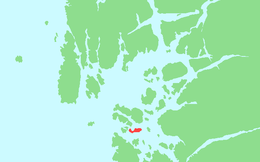Åmøy
Åmøy is an island that is divided between Rennesøy and Stavanger municipalities in Rogaland county, Norway. The 5.3-square-kilometre (2.0 sq mi) island lies just north of the city of Stavanger in a group of islands. The islands of Sokn and Bru both lie to the west of Åmøy and the islands of Mosterøy and Rennesøy lie to the north, and the island of Hidle lies to the east.[1]
Åmøy (top, right corner) | |
 Location in Rogaland county | |
| Geography | |
|---|---|
| Location | Rogaland, Norway |
| Coordinates | 59.0434°N 05.6912°E |
| Area | 5.3 km2 (2.0 sq mi) |
| Administration | |
Norway | |
| County | Rogaland |
| Municipality | Rennesøy |
| Demographics | |
| Population | 618 (2014) |
| Pop. density | 116.6/km2 (302/sq mi) |
Geography
The island is a long, narrow island with a very narrow isthmus in the middle. The western part of the island (Vestre Åmøy) is part of Rennesøy municipality. The eastern part (Austre Åmøy) is part of Stavanger municipality. Both halves of the island have their own chapel, Austre Åmøy Chapel and Vestre Åmøy Chapel. In 2014, there were 618 people living on the island with 328 living on the Rennesøy part and the remaining 290 people living in the Stavanger part.[1] Austre Åmøy sorts under the burrough of Tasta.[2]
The island was served by local boats for many years. In 1992 Åmøy was connected to the mainland via road bridge to Sokn, with further connection to the subsea Byfjord Tunnel.[2][3]
There have been efforts by some residents of the eastern half of the island to have a referendum that would transfer them from Stavanger to Rennesøy, thus uniting the island under one municipal government, but efforts have not been successful with no clear majority on the island wanting to change.[4][5][6]
History
Nearly 1,000 rock carvings, dated from the Bronze Age, are found at the island.[2][8] Among the picture motifs are people, animals, fish, ships and tools.[3] Ostensibly. the Meling farm, claims to have the "largest concentration of rock carvings in Rogaland." Larger petroglyph fields are signed and open to the public. It is claimed that they were the product of a "cult" that viewed "the sun [as] an animating factor." Many varieties of ships appear, and are evidently a significant religious symbol — metaphorically interpreted as symbols of holiness, power, and means of transportation to the sun and divinity.[8] There have also been found prehistoric sites from the Stone Age and Iron Age, including burial mounds and foundations for living houses and boathouses.[2][9][10]
See also
References
- Store norske leksikon. "Åmøy" (in Norwegian). Retrieved 2015-12-11.
- "Austre Åmøy". Stavanger byleksikon (in Norwegian). Stavanger: Wigestrand. 2008. ISBN 978-82-8140-017-7.
- Thomsen, Hanne, ed. (2003). Rogaland (in Norwegian). Stavanger: Wigestrand. pp. 280–281. ISBN 82-91370-48-6.
- Seglem, Elisabeth (19 April 2005). "Stavanger and Rennesoy parts Amoy there between: Now Amoy Arch want referendum Amoy residents will gather". Stavanger Aftenblad (in Norwegian). Retrieved 18 December 2015.
- Grimen, Bjørn (2013-04-23). "Stavanger kommune gir oss ingenting". NRK Rogaland (in Norwegian). Retrieved 2015-12-11.
- Nibe, Bjørn (2014-04-24). "Austre Åmøy: Nei til Rennesøy kommune". Tastavis (in Norwegian). Retrieved 2015-12-11.
- "Meling – Åmøy IV". Kulturminnesøk (in Norwegian). Norwegian Directorate for Cultural Heritage. Retrieved 19 December 2015.
- "Austre Åmøy Rock Carvings". Spotting History. Retrieved December 18, 2015.
- "MELINGSVÅGEN". Kulturminnesøk (in Norwegian). Norwegian Directorate for Cultural Heritage. Retrieved 19 December 2015.
- "Meling". Kulturminnesøk (in Norwegian). Norwegian Directorate for Cultural Heritage. Retrieved 19 December 2015.
External links
- Garborg, Dag Rune (October 13, 2014). "Åmøy" (Video). YouTube. Retrieved December 18, 2015.
- "Flying wild åmøy! [GoPro on multiplex mentor]" (Video). YouTube. October 13, 2014. Retrieved December 18, 2015.